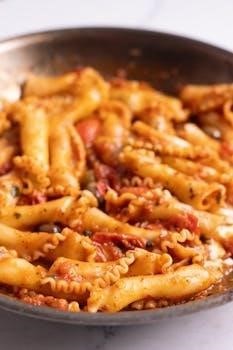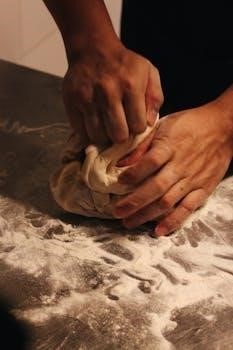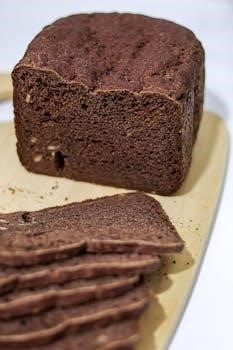Common Crossword Answers for “Recipe Instruction”
Crossword puzzles frequently feature “recipe instruction” as a clue, yielding several common answers. These range from short action words to slightly longer, more descriptive terms. The solutions often depend on the grid’s length requirements. Common short answers are “ADD”, “MIX”, and “STIR”.
Most Frequent 3-Letter Answers
When crossword puzzles seek a 3-letter answer for “recipe instruction,” certain words consistently appear. The most prevalent is “ADD,” a fundamental direction in cooking that signifies incorporating one ingredient into another. Another common 3-letter solution is “MIX,” which indicates combining multiple elements, often through stirring or beating. A less frequent, but still possible, answer is “USE,” which refers to employing an ingredient or utensil. These three-letter options provide straightforward actions that are crucial to many cooking processes. The brevity of these words makes them ideal for fitting into tight crossword grids. They represent basic steps, often the starting point in a recipe, that are easily recalled by solvers. These instructions are foundational and require no further explanation. They act as cornerstones of the recipe’s direction. Additionally, “BEA” as an abbreviation for “BEAT” could sometimes appear.
Most Frequent 4-Letter Answers
For 4-letter crossword answers related to “recipe instruction,” the most frequent solution is “STIR”. This term indicates a common cooking method of moving ingredients in a circular motion. Other frequent 4-letter answers that might appear include “BAKE,” referencing a dry-heat cooking method often used in recipes. “BEAT” which also indicates a mixing action, also tends to pop up in puzzles. “HEAT” could also fit if the recipe step is to heat up an ingredient. These words represent basic cooking processes that are easily understood. Their four-letter length makes them versatile for crossword construction. The simplicity and directness of these words make them popular choices for puzzle setters. They are used when a more specific instruction than three letter word is needed. These actions are crucial for various types of dishes. This ensures a balance between common cooking actions and crossword puzzle constraints. The user can often predict these answers.
Most Frequent 5-Letter Answers
When “recipe instruction” clues require a 5-letter answer, several common words appear in crossword puzzles. Among them, “MINCE” is a frequently used solution, referring to finely chopping food. Another common answer is “SAUTE,” which describes cooking ingredients in a small amount of fat over heat. “STEPS,” while not a direct action, is also a very common answer, often referring to the individual parts of the recipe instructions. “BASTE” is another possible answer, meaning to moisten food during cooking. The 5-letter length allows for more specific cooking actions to be included. These terms offer a bit more detail than the shorter options, adding to the challenge of the crossword. They are often tied to specific methods and techniques. These actions are often seen in various cooking scenarios and are therefore very likely to appear in crosswords. The puzzle setter can use these words for specific types of recipes. The user must be familiar with the language of cookery to solve these clues.
Most Frequent 6-Letter Answers
For crossword clues related to “recipe instruction” that demand a six-letter answer, several solutions frequently surface. The most notable of these is “STIRIN”, which indicates the action of combining ingredients using a stirring motion. This answer often appears when the puzzle is looking for a slightly more specific or complex action; Another common six-letter solution is “MIXIN,” which is similar to “STIRIN” and also relates to the combination of components. These answers are more specific than the three and four-letter options. The extra two letters allow for the inclusion of suffixes like “-in”, which adds the nuance of an action being performed. The six-letter length provides a space for the crossword puzzle maker to go into more detail. These terms are a bit less general than “STIR” or “MIX,” making the clue slightly more challenging and interesting. The solver needs to pay attention to the precise meaning of the clue to get the correct answer. These answers also demonstrate the way recipes can be written in a more precise and technical way.

Specific Recipe Instruction Clues and Solutions
Crossword puzzles often feature more specific clues for recipe instructions. These may include phrases like “Recipe Instruction (2 wds.)” or “Cocktail Recipe Instruction,” demanding more tailored answers, which are often longer.
“Recipe Instruction (2 wds.)” Solutions
When crossword puzzles specify “Recipe Instruction (2 wds.)”, solvers need to think of two-word phrases that commonly appear in recipes. These solutions often describe a process or technique rather than a single action. While single words like “stir” or “bake” are common, this clue requires a phrase. Examples found in puzzle databases include “ADD SALT,” “MIX IN,” or “STIR IN,” each conveying a more detailed step. These two-word answers can be tricky, as they require a bit more thought than single-word instructions. The specific letters available in the grid will significantly determine which two-word solution fits, making it essential to consider all possibilities. Crossword solvers must analyze the grid carefully to find the right combination of words that fit both the clue and the space available.
“Cocktail Recipe Instruction” Solutions
Crossword clues specifying “Cocktail Recipe Instruction” often point towards actions specific to making drinks. These instructions might involve mixing, shaking, or stirring, often using specialized bar tools. Common solutions include terms like “SHAKE,” referring to the technique of vigorously mixing ingredients with ice. Another possible answer is “STIR,” typically used for cocktails that should be blended gently. “ADD ICE” could also appear, relating to a crucial step in many cocktail recipes. Words like “MUDDLE,” for crushing ingredients to release their flavor, or “POUR” are also frequent solutions. The context of cocktail preparation adds a layer of specificity to these instructions. Crossword solvers should think about standard bar techniques and actions. The answer will usually be a verb describing a typical step.
“Soup Recipe Instruction” Solutions
When a crossword clue specifies “Soup Recipe Instruction,” the answers typically revolve around actions associated with soup preparation. These words often describe cooking methods or steps in the process. Frequent solutions include “SIMMER,” suggesting gentle cooking over low heat, or “BOIL,” indicating a more rapid heating process. “ADD” is a common solution, reflecting the need to incorporate ingredients into the soup. Other possibilities include “STIR,” for blending the components, or “SAUTE,” which might be part of the initial steps for some recipes. The instruction could also be “PUREE,” if the soup requires a smooth consistency. Crossword solvers should consider the various stages and methods involved in making soup. Common verbs related to cooking soups are often the correct answers. These words are directly related to the process of creating soup.
“Pasta Recipe Instruction” Solutions
Crossword clues specifying “Pasta Recipe Instruction” often lead to answers that describe actions central to preparing pasta dishes. The word “BOIL” frequently appears, relating to the cooking method of pasta in water. Other common solutions include “ADD,” indicating the addition of pasta to water or a sauce. “STIR” is another frequent answer, referencing the action of mixing pasta with sauce. “DRAIN” is also possible, describing the process after cooking. For more intricate pasta dishes, “SAUTE” might appear when vegetables or sauces are being prepared as a part of the recipe. Also, “TOSS” can be the answer, signifying the action of combining the pasta with other ingredients. The specific word depends on the length requirement of the puzzle grid, so consider the usual steps of preparing a pasta dish. The key actions are always the best answers.

Crossword Puzzle Context
Recipe instruction clues are common in various crossword puzzles, including the NY Times and Daily Celebrity. These clues appear across different difficulty levels and publications, highlighting their widespread use.
Crossword Puzzle Sources
Recipe instruction clues are frequently encountered in a wide variety of crossword puzzle sources, ranging from well-known publications to more specialized puzzle books. Major newspapers like the New York Times, Los Angeles Times, and the Daily Mirror often feature these types of clues. Additionally, you’ll find them in syndicated puzzles such as those by Thomas Joseph. Online crossword platforms and apps, including those offering daily puzzles, also commonly use recipe-related instructions as clues. These sources cater to different skill levels, meaning that the difficulty of the “recipe instruction” clue, and its corresponding answer, can vary significantly. The prevalence of this clue across diverse platforms demonstrates its common appeal and universal applicability within the crossword puzzle context. The frequency ensures both novice and expert puzzlers encounter this type of clue.
Frequency in Different Puzzles
The frequency of “recipe instruction” clues varies across different crossword puzzles, often depending on the puzzle’s difficulty and theme. In easier puzzles, like those found in daily newspapers, the answers are typically shorter and more common, such as “ADD,” “MIX,” or “STIR.” More challenging puzzles, like those in the New York Times or cryptic crosswords, may use longer or less straightforward answers, possibly including two-word phrases like “STIR IN” or cooking methods such as “SAUTE”. Themed puzzles, especially those related to food or cooking, tend to include these clues more often. The frequency also depends on the puzzle’s overall grid structure, where the placement of longer answers may necessitate a shorter, more common “recipe instruction” solution. Ultimately, the frequency and specific answer chosen are influenced by the puzzle’s target audience and intended level of complexity.

Types of Recipe Instructions
Recipe instructions can be categorized by cooking methods, like “BAKE” or “SAUTE,” or by action-based directives, such as “STIR” or “MINCE.” These words are frequently used in crossword puzzles.
Cooking Methods as Instructions
Many recipe instructions directly employ cooking methods as verbs. Words like “BAKE,” “BOIL,” “SAUTE,” and “FRY” are common examples found in both recipes and crossword puzzles. These terms specify the technique used to prepare the food, often acting as a concise direction. For instance, a recipe might instruct you to “BAKE” the cake for 30 minutes, or “SAUTE” the onions until golden brown. These cooking methods also translate well into crossword clues due to their brevity and common usage. Understanding these terms is essential not only for cooking but also for solving puzzles related to recipe instructions. They offer clear, actionable steps in a recipe and are easy to recall when encountered in a crossword grid. The selection of a specific method impacts the final dish’s taste and texture, thus making it a key instruction. Other methods such as “BROIL”, “STEAM”, or “GRILL” might also be used depending on the dish.
Action-Based Instructions
Beyond cooking methods, many recipe instructions focus on action-based verbs that guide the preparer through the steps. Words like “STIR,” “MIX,” “ADD,” and “MINCE” frequently appear as crossword answers for “recipe instruction.” These terms describe specific actions needed to combine ingredients or prepare them for cooking. For example, a recipe might tell you to “STIR” the sauce continuously, or “ADD” the spices at a particular point. “BEAT” is another action-based verb, often used in baking. Similarly, “CHOP,” “SLICE,” and “DICE” may also be included for preparing ingredients. These action-oriented terms are crucial for understanding the process and are succinct enough for crossword clues. They provide clear direction, ensuring that the cook correctly follows the recipe. The verbs often come before the ingredient they modify and are essential for recipe understanding and puzzle solving.

Other Related Crossword Clues
Clues related to “recipe instruction” often include “dish instructions” or “recipe direction,” which also use similar action-based words. These related clues can lead to overlapping answers, such as “STIR” or “ADD”.
“Dish Instructions” Clue
The crossword clue “Dish Instructions” is closely related to “Recipe Instruction” and often shares similar answers. When encountering this clue, solvers should consider action-oriented verbs commonly used in cooking. These might include terms like “BAKE,” “BOIL,” “FRY,” or “SAUTE,” depending on the grid’s letter count. The context of the puzzle, as well as previously filled-in words, can provide valuable clues to the correct solution. Furthermore, words like “MIX” and “STIR” are also potential solutions. The key is to look for directives that describe how to prepare a particular dish. This clue can sometimes also refer to the presentation or serving methods, not just the cooking process itself. Therefore, words like “PLATE” might be a possible solution, although this is less common. Crossword solvers should be prepared for a variety of possible solutions.
“Recipe Direction” Clue
The crossword clue “Recipe Direction” is another common variation that typically points towards action verbs found in cooking procedures. This clue asks for a word that describes a step or instruction within a recipe. Solutions frequently include terms like “ADD,” “MIX,” “STIR,” “FOLD,” or “WHISK.” The length of the answer is determined by the puzzle grid, so solvers should pay close attention to the number of spaces available. More specific actions, such as “SAUTE” or “BAKE,” can also be solutions if the letter count matches the crossword puzzle’s requirements. The clue may sometimes hint at a more general direction, such as a word implying order or sequence, like “STEP”. Therefore, a solver needs to consider various possibilities. The context of the other intersecting words in the puzzle can help narrow down the right answer.

